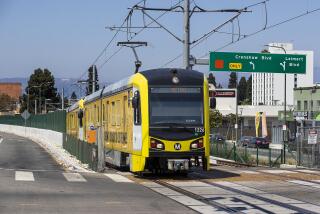Report: Closing the 710 Freeway gap would take years and cost billions
Any major modifications to the unfinished 710 Freeway, one of Los Angeles Countyâs most persistent transportation controversies, would cost billions of dollars and take years to complete, according to environmental documents released Friday.
In a 2,260-page draft environmental report, the California Department of Transportation and the Los Angeles County Metropolitan Transportation Authority examined four construction options they say could address the congestion and health issues that stem from the 710âs abrupt ending on a surface street in Alhambra. The freeway is a favored route for truckers shuttling between the ports of Los Angeles and Long Beach and distribution centers in central Los Angeles County.
âThis area is widely considered to have an incomplete transportation infrastructure,â Metro spokesman Paul Gonzales told the Los Angeles Times. âThe way it affects the region is part of this study -- what it means for traffic, what it means for mobility, what it means for air pollution. We closely associate the 710 with a handful of specific cities, but itâs connected to the whole region.â
To address the 4.5-mile gap through Alhambra and South Pasadena, the agencies are considering a bus system, a light-rail line, a freeway tunnel and a range of upgrades to the existing route, as well as the required âno buildâ option.
Building an underground freeway would be the most expensive option. Tunneling between the 10 Freeway and the nexus of the 210 and 134 freeways in Pasadena would cost between $3.1 billion and $5.6 billion and would take about five years to complete, the report said.
The $5.6-billion freeway option calls for side-by-side, double-decker tunnels to separate northbound and southbound traffic. The route would feature a 4.9-mile tunnel and 1.4 miles of surface-level freeway.
The $3.1-billion option calls for one double-decker freeway tunnel. Northbound traffic would use the two lanes on the upper level, and southbound traffic would use the lower level.
A 4.9-mile tunnel would be the longest in California, and almost as long as downtown Bostonâs 5.1-mile Big Dig tunnel. Under either option, drivers could be charged a toll and trucks could be barred from the tunnels, the report said.
A 12-mile rapid bus route would link Huntington Drive in San Marino to Whittier Boulevard in Montebello, according to the environmental analysis. Buses would have some dedicated lanes, and could run every 10 minutes during peak hours. Adding the bus routes would cost $241 million and take about two years.
A 7.5-mile light-rail line would cost $2.4 billion and would add seven stops to Los Angeles Countyâs growing rail system, the report said, connecting the Gold Lineâs Fillmore Station in Pasadena with the East L.A. Civic Center stop. The route would run underground through Pasadena and South Pasadena, then run on elevated tracks through Monterey Park and East Los Angeles. Construction would take about six years.
The cheapest option would be to make the existing freeways and roads more efficient without major construction, the report says. That could include meters for on-ramps, synchronized traffic signals, and lanes that change direction during peak hours. Those options would cost about $105 million and take two years to complete, the report said.
Caltrans and Metro are accepting comments from the public until July 6. The Metro board of directors will choose a final option for the project sometime in 2016, Gonzales said.
The 710 project has $780 million in funding through Measure R, the half-cent sales tax for transportation projects that county voters approved in 2008. Selecting a light-rail or tunnel option would require that Metro seek additional federal, state or local funds.
For more Los Angeles transportation news, follow @laura_nelson on Twitter.
More to Read
Sign up for Essential California
The most important California stories and recommendations in your inbox every morning.
You may occasionally receive promotional content from the Los Angeles Times.











